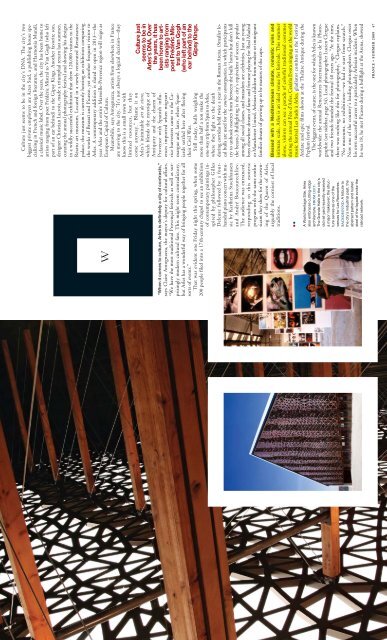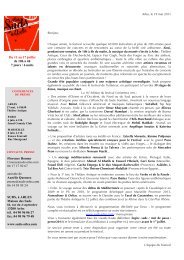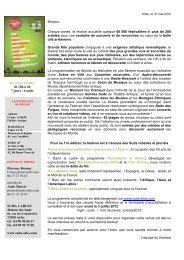GEO correspond-il à vos attentes ? - Les Suds à Arles
GEO correspond-il à vos attentes ? - Les Suds à Arles
GEO correspond-il à vos attentes ? - Les Suds à Arles
You also want an ePaper? Increase the reach of your titles
YUMPU automatically turns print PDFs into web optimized ePapers that Google loves.
Culture just seems to be in the city’s DNA. The city’s two<br />
biggest private employers are Actes Sud, a publishing house specializing<br />
in French and foreign literature, and Harmonia Mundi,<br />
a classical music label. Over the years, the city has been home to<br />
artists ranging from poet Frédéric Mistral to Van Gogh (who left<br />
part of an ear behind) to the Gipsy Kings. Another favorite son,<br />
designer Christian Lacroix, made a triumphal return last summer,<br />
curating the annual photography festival and showing his designs<br />
in a w<strong>il</strong>dly successful exhibition that drew 120,000 visitors to the<br />
Réattu art museum. Located in a newly renovated Renaissance<br />
palace, the museum is currently hosting an exhibition comparing<br />
the works of Brassaï and Picasso, yet another frequent visitor to<br />
<strong>Arles</strong>. A contemporary addition is slated to open in 2013—the<br />
year <strong>Arles</strong> and the entire Marse<strong>il</strong>le-Provence region w<strong>il</strong>l reign as<br />
European Capital of Culture.<br />
Meanwh<strong>il</strong>e, says Antognazza, artists from elsewhere in France<br />
are moving to the city. “It’s not always a logical decision—they<br />
know this is a small town with<br />
limited resources, but they<br />
come anyway.” Blame it on<br />
Culture just<br />
<strong>Arles</strong>’s inimitable art de vivre,<br />
seems to be in<br />
which blends the mystique of <strong>Arles</strong>’s DNA. Over<br />
Antiquity and the charm of the years, it has<br />
Provence with Spanish influ- been home to artences<br />
imported when migrant ists ranging from<br />
rice harvesters came to the Ca- poet Frédéric Mismargue<br />
and, later, when Spantral to Van Gogh<br />
iards settled here after fleeing (who left part of an<br />
their Civ<strong>il</strong> War.<br />
ear behind) to the<br />
St<strong>il</strong>l today, bulls weighing<br />
Gipsy Kings.<br />
more than half a ton make the<br />
one-way trip from Spain to <strong>Arles</strong>,<br />
where they fight to the death<br />
during corridas held twice a year in the Roman Arena. (Smaller local<br />
bulls are used for the courses camarguaises, in which participants<br />
try to unhook rosettes from between the bulls’ horns but don’t k<strong>il</strong>l<br />
the beasts.) Bullfighting is the city’s equivalent of soccer, popular<br />
among all social classes, and matadors are celebrities. Just as young<br />
boys elsewhere dream of fame and fortune playing for Real Madrid<br />
or Manchester United, <strong>Arles</strong>ian ch<strong>il</strong>dren from modest or immigrant<br />
fam<strong>il</strong>ies dream of growing up to be masters of the cape.<br />
w<br />
“When it comes to culture, <strong>Arles</strong> is definitely a city of contrasts,”<br />
says Claire Antognazza, the mayor’s deputy for cultural affairs.<br />
“We have the most traditional Provençal festivals as well as surprisingly<br />
modern cultural fare. This might seem contradictory,<br />
but <strong>Arles</strong> has a wonderful way of bringing people together for all<br />
sorts of events.”<br />
That was evident one Friday night this spring, when some<br />
200 people f<strong>il</strong>ed into a 17th-century chapel to see an exhibition<br />
of contemporary paintings inspired<br />
by ph<strong>il</strong>osopher G<strong>il</strong>les<br />
Deleuze followed by a fourhanded<br />
piano concert with music<br />
by Karlheinz Stockhausen<br />
and André Boucourechliev.<br />
The audience was entranced,<br />
responding to this esoteric<br />
program with the same enthusiasm<br />
they show for the crowning<br />
of the Queen of <strong>Arles</strong>,<br />
arguably the corniest of local<br />
traditions.<br />
Blessed with a Mediterranean climate, romantic ruins and<br />
intimate scale, <strong>Arles</strong> is an ideal venue for festivals. This summer<br />
alone, visitors can see a parade of colorful traditional costumes<br />
during the annual Fête d’<strong>Arles</strong>, Cesária Evora singing at the world<br />
music festival <strong>Les</strong> <strong>Suds</strong> <strong>à</strong> <strong>Arles</strong>, gladiator combats at the Festival<br />
Arelate and epic f<strong>il</strong>ms shown at the Théâtre Antique during the<br />
Peplum festival.<br />
The biggest event, of course, is the one for which <strong>Arles</strong> is known<br />
worldwide: the annual Rencontres Internationales de la Photographie<br />
(see sidebar, page 34). Local photographer Lucien Clergue<br />
and two friends founded the festival 40 years ago. “At the time,<br />
there was nothing like this for photography,” Clergue explains.<br />
“No museums, no exhibitions—we had to start from scratch.”<br />
Now one of the country’s leading photographers, Clergue owes<br />
his own successful career to a particularly <strong>Arles</strong>ian incident: When<br />
he was 18, he met Picasso during a bullfight at the Arena, showed<br />
A World Heritage Site, <strong>Arles</strong><br />
also embraces cutting-edge<br />
architecture. from left:<br />
The Grande Halle in the city’s<br />
old ra<strong>il</strong> yard recently received<br />
a major makeover; the structure<br />
serves as one of the<br />
venues for <strong>Les</strong> Rencontres.<br />
baCkground: A tribute to<br />
the city’s industrial past, the<br />
abstract pattern and rusted<br />
steel of the façade evoke the<br />
ra<strong>il</strong>road network.<br />
France • summer 2009 47





